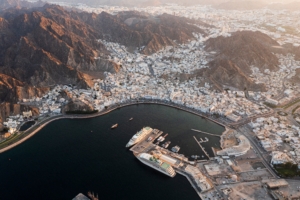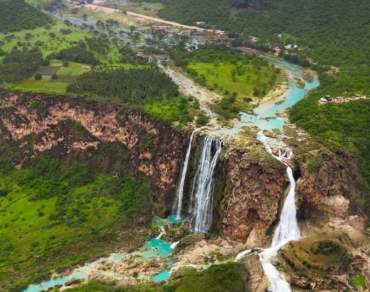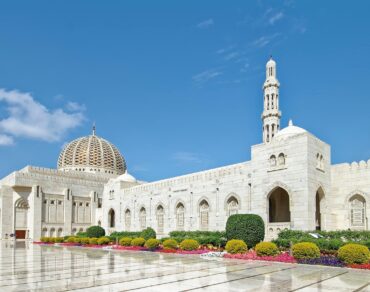
-
Oman Tour Packages > Blog > Discover the Breathtaking Landscape in Oman: A Traveler’s Guide

Discover the Breathtaking Landscape in Oman: A Traveler’s Guide
The Omani landscape left me speechless during my first visit. Pristine beaches stretch along the Arabian Sea while rugged mountain ranges pierce the clouds. This hidden gem of the Arabian Peninsula shows off natural wonders that few travelers expect to find in the Middle East.
Oman’s landscape amazes visitors with an incredible mix of terrains you rarely see in one country. Wadis (valleys) cut through ancient mountains, while vast desert dunes change colors with the sun. Lush green oases nestle between rocky cliffs, and each vista tells its own story.
Let’s take a closer look at the different regions of Oman and help you plan the perfect time to visit each area. We’ll share great tips to experience these natural wonders responsibly. Adventure seekers and nature photographers will find why Oman’s dramatic scenery deserves a spot on their travel bucket list.
Understanding Oman’s Diverse Landscapes
Oman’s territory reveals three distinct physiographic zones that shape its northern region. The Al-Ḥajar Mountains stand as the most striking feature, an impressive range that soars above 4,800 feet. Mount Shams reaches 9,777 feet and claims the title of the country’s highest point.
Geographic formations create remarkable diversity across Oman’s landscape. The long, narrow coastal plain of Al-Bāṭinah runs along the Gulf of Oman, while the great central divide of Wadi Samāʾil cuts the Ḥajar into western and eastern ranges. The terrain gradually descends southwest into the vast Rubʿ al-Khali (“Empty Quarter”) desert that Oman shares with neighboring countries.
Oman’s climate zones show fascinating variations:
 Best Times to Visit Different Regions
Let me share my insights about the best times to visit Oman’s amazing regions, based on my years of exploring this beautiful country.
Seasonal highlights by region
The best time to experience Oman’s stunning landscape runs from October to April. The weather stays pleasantly warm at around 28°C. The northern parts of the country, including Muscat and the Al Hajar Mountains, look their best during these months. The mountain areas are spectacular between October and March, with comfortable daytime temperatures of 24°C.
Best Times to Visit Different Regions
Let me share my insights about the best times to visit Oman’s amazing regions, based on my years of exploring this beautiful country.
Seasonal highlights by region
The best time to experience Oman’s stunning landscape runs from October to April. The weather stays pleasantly warm at around 28°C. The northern parts of the country, including Muscat and the Al Hajar Mountains, look their best during these months. The mountain areas are spectacular between October and March, with comfortable daytime temperatures of 24°C.
 Festival and event timing
Oman’s festivals paint a vibrant picture of its changing landscape year-round. The Muscat Festival runs through January-February with pleasant winter temperatures that make cultural exploration a joy. The Salalah Tourism Festival happens in July-August during the Khareef season. The southern region turns into a green paradise at this time.
March brings the exciting Sultan Camel Race Cup. This traditional sport comes alive against the desert backdrop. Nature lovers should plan their visits between June and September. That’s the perfect time to see turtles nesting at Ras Al Jinz.
Planning Your Landscape Journey
After exploring different landscapes and the best times to visit, let’s tuck into the practical side of planning your experience through Oman’s natural wonders.
Transportation options and accessibility
A rental car provides the most flexibility to explore Oman’s varied terrain. The country has an excellent network of roads that are well-kept. You’ll need a 4WD vehicle in certain areas. Police checkpoints won’t let you drive up Jebel Akhdar without a 4×4.
Mwasalat runs intercity buses, if you prefer guided transport. Their smartphone app helps you plan your trips effectively. Cities have both metered government taxis (red and white) and private taxis (orange and white) that you can easily find.
Festival and event timing
Oman’s festivals paint a vibrant picture of its changing landscape year-round. The Muscat Festival runs through January-February with pleasant winter temperatures that make cultural exploration a joy. The Salalah Tourism Festival happens in July-August during the Khareef season. The southern region turns into a green paradise at this time.
March brings the exciting Sultan Camel Race Cup. This traditional sport comes alive against the desert backdrop. Nature lovers should plan their visits between June and September. That’s the perfect time to see turtles nesting at Ras Al Jinz.
Planning Your Landscape Journey
After exploring different landscapes and the best times to visit, let’s tuck into the practical side of planning your experience through Oman’s natural wonders.
Transportation options and accessibility
A rental car provides the most flexibility to explore Oman’s varied terrain. The country has an excellent network of roads that are well-kept. You’ll need a 4WD vehicle in certain areas. Police checkpoints won’t let you drive up Jebel Akhdar without a 4×4.
Mwasalat runs intercity buses, if you prefer guided transport. Their smartphone app helps you plan your trips effectively. Cities have both metered government taxis (red and white) and private taxis (orange and white) that you can easily find.
 Accommodation near major landscapes
Oman has a variety of places to stay that match every traveler’s needs. Here’s what you can expect:
Accommodation near major landscapes
Oman has a variety of places to stay that match every traveler’s needs. Here’s what you can expect:
- Summer temperatures in coastal regions climb to 110°F (43°C) with hot, humid conditions
- Similar temperatures prevail in interior areas, but humidity stays low
- Mountain regions remain cool throughout the year
- Unique monsoon influences benefit the southern Dhofar region
 Best Times to Visit Different Regions
Let me share my insights about the best times to visit Oman’s amazing regions, based on my years of exploring this beautiful country.
Seasonal highlights by region
The best time to experience Oman’s stunning landscape runs from October to April. The weather stays pleasantly warm at around 28°C. The northern parts of the country, including Muscat and the Al Hajar Mountains, look their best during these months. The mountain areas are spectacular between October and March, with comfortable daytime temperatures of 24°C.
Best Times to Visit Different Regions
Let me share my insights about the best times to visit Oman’s amazing regions, based on my years of exploring this beautiful country.
Seasonal highlights by region
The best time to experience Oman’s stunning landscape runs from October to April. The weather stays pleasantly warm at around 28°C. The northern parts of the country, including Muscat and the Al Hajar Mountains, look their best during these months. The mountain areas are spectacular between October and March, with comfortable daytime temperatures of 24°C.
- Desert Plains (October-March): Temperatures above 25°C
- Mountain Regions (March-April/September-October): Daytime highs of 24°C
- Coastal Areas (March-April): Perfect for beach activities
- Dhofar Region (June-September): Unique monsoon season
 Festival and event timing
Oman’s festivals paint a vibrant picture of its changing landscape year-round. The Muscat Festival runs through January-February with pleasant winter temperatures that make cultural exploration a joy. The Salalah Tourism Festival happens in July-August during the Khareef season. The southern region turns into a green paradise at this time.
March brings the exciting Sultan Camel Race Cup. This traditional sport comes alive against the desert backdrop. Nature lovers should plan their visits between June and September. That’s the perfect time to see turtles nesting at Ras Al Jinz.
Planning Your Landscape Journey
After exploring different landscapes and the best times to visit, let’s tuck into the practical side of planning your experience through Oman’s natural wonders.
Transportation options and accessibility
A rental car provides the most flexibility to explore Oman’s varied terrain. The country has an excellent network of roads that are well-kept. You’ll need a 4WD vehicle in certain areas. Police checkpoints won’t let you drive up Jebel Akhdar without a 4×4.
Mwasalat runs intercity buses, if you prefer guided transport. Their smartphone app helps you plan your trips effectively. Cities have both metered government taxis (red and white) and private taxis (orange and white) that you can easily find.
Festival and event timing
Oman’s festivals paint a vibrant picture of its changing landscape year-round. The Muscat Festival runs through January-February with pleasant winter temperatures that make cultural exploration a joy. The Salalah Tourism Festival happens in July-August during the Khareef season. The southern region turns into a green paradise at this time.
March brings the exciting Sultan Camel Race Cup. This traditional sport comes alive against the desert backdrop. Nature lovers should plan their visits between June and September. That’s the perfect time to see turtles nesting at Ras Al Jinz.
Planning Your Landscape Journey
After exploring different landscapes and the best times to visit, let’s tuck into the practical side of planning your experience through Oman’s natural wonders.
Transportation options and accessibility
A rental car provides the most flexibility to explore Oman’s varied terrain. The country has an excellent network of roads that are well-kept. You’ll need a 4WD vehicle in certain areas. Police checkpoints won’t let you drive up Jebel Akhdar without a 4×4.
Mwasalat runs intercity buses, if you prefer guided transport. Their smartphone app helps you plan your trips effectively. Cities have both metered government taxis (red and white) and private taxis (orange and white) that you can easily find.
 Accommodation near major landscapes
Oman has a variety of places to stay that match every traveler’s needs. Here’s what you can expect:
Accommodation near major landscapes
Oman has a variety of places to stay that match every traveler’s needs. Here’s what you can expect:
- Luxury Mountain Retreats: Perfect for exploring the Hajar Mountains
- Desert Camps: Ideal for Wahiba Sands experiences
- Beachfront Resorts: Along the coastal regions
- Traditional Guesthouses: Near cultural sites
- Major resorts recycle 80% of organic and glass waste
- Sustainable properties achieved 18.3% energy and 37% water savings in 2023
- Protected areas operate under strict environmental regulations
Related Tours
Related Tours
Test2
© 2025 Oman Tour Packages. All rights reserved.



